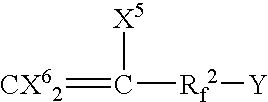Process for preparing vulcanizable fluorine-containing elastomer
a technology of vulcanizable fluorine and elastomer, which is applied in the field of process for preparing vulcanizable fluorinecontaining elastomer, can solve the problems of lowering the elongation at break, not being suitable for sealing materials, and inferior compression set to polyol vulcanization type, etc., and achieves high terminal iodine content and high productivity.
- Summary
- Abstract
- Description
- Claims
- Application Information
AI Technical Summary
Benefits of technology
Problems solved by technology
Method used
Image
Examples
reference example 1
Polymerization for Seed Polymer Particles
[0122] A 1.8 liter polymerization vessel equipped with an electromagnetic induction type stirring device as a stirring device was charged with 720 g of deionized water, 290 g of a 10% by weight aqueous solution of ammonium perfluorooctanate and 0.6 g of diethyl malonate. After the system was sufficiently replaced with nitrogen gas, the pressure was reduced. This procedure was repeated 3 times. Under reduced pressure, 20 g of VdF and 51 g of HFP were added thereto, and the temperature was raised to 80° C. with stirring. Subsequently, 0.02 g of ammonium persulfate (APS) dissolved in 0.6 g of deionized water was injected into the system by nitrogen gas to start polymerization. The polymerization pressure was set to 2 MPa, and in order to compensate for the pressure decrease during the polymerization, a monomer mixture of VdF / HFP (78 / 22 (% by mole)) was supplied continuously and the polymerization was conducted with stirring. By the completion o...
reference example 2
Polymerization for Seed Polymer Particles
[0124] A 1.8 liter polymerization vessel equipped with an electromagnetic induction type stirring device as a stirring device was charged with 809 g of deionized water, 200 g of a 10% by weight aqueous solution of ammonium perfluorooctanate. After the system was sufficiently replaced with nitrogen gas, the pressure was reduced. This procedure was repeated 3 times. Under reduced pressure, 0.5 mililiter of isopentane was charged into the vessel, and VdF, TFE and HFP were added thereto so that the composition of VdF / TFE / HFP in the vessel was 29.0 / 13.0 / 58.0 (% by mole) at 80° C. and the inner pressure of the vessel was 1.4 MPa. After the completion of the temperature elevation, 0.67 g of ammonium persulfate (APS) dissolved in 20 g of deionized water was injected into the system by nitrogen gas to start polymerization. The polymerization pressure was set to 1.4 MPa, and in order to compensate for the pressure decrease during the polymerization, a...
example 1
[0126] A 2.5 liter polymerization vessel equipped with the same electromagnetic induction type stirring device as in Reference Example 1 was charged with 1,324 g of deionized water, 33.5 g of an aqueous dispersion of the polymer particles prepared in Reference Example 1 and 19.1 g of a 10% by weight aqueous solution of ammonium perfluorooctanate. After the system was sufficiently replaced with nitrogen gas, the pressure was reduced. This procedure was repeated 3 times, and 171 g of VdF and 729 g of HFP were added under reduced pressure, and the temperature was raised to 80° C. with stirring. Subsequently, 2.98 g of octafluoro-1,4-diiodobutane and 0.068 g of APS dissolved in 15 g of deionized water were injected by nitrogen gas to start polymerization, and the polymerization was continued under the following conditions (a) to (c). After 4.3 hours, stirring was stopped and the monomers were discharged to stop the polymerization.
[0127] (a) The critical temperature and critical pressur...
PUM
| Property | Measurement | Unit |
|---|---|---|
| elongation at break Eb | aaaaa | aaaaa |
| elongation at break Eb | aaaaa | aaaaa |
| elongation at break Eb | aaaaa | aaaaa |
Abstract
Description
Claims
Application Information
 Login to View More
Login to View More - R&D
- Intellectual Property
- Life Sciences
- Materials
- Tech Scout
- Unparalleled Data Quality
- Higher Quality Content
- 60% Fewer Hallucinations
Browse by: Latest US Patents, China's latest patents, Technical Efficacy Thesaurus, Application Domain, Technology Topic, Popular Technical Reports.
© 2025 PatSnap. All rights reserved.Legal|Privacy policy|Modern Slavery Act Transparency Statement|Sitemap|About US| Contact US: help@patsnap.com



